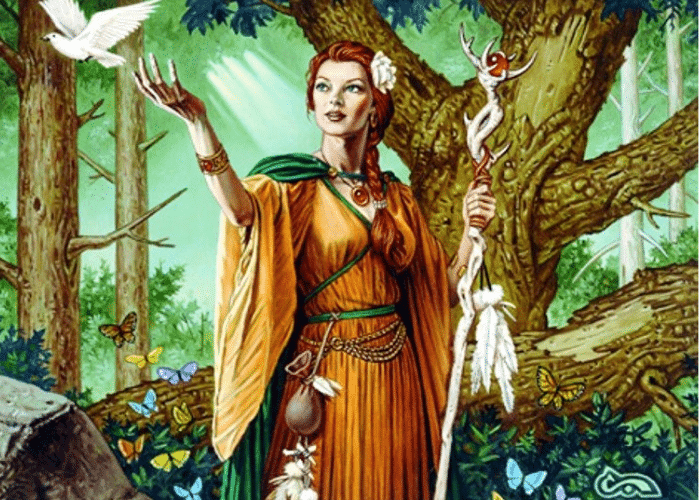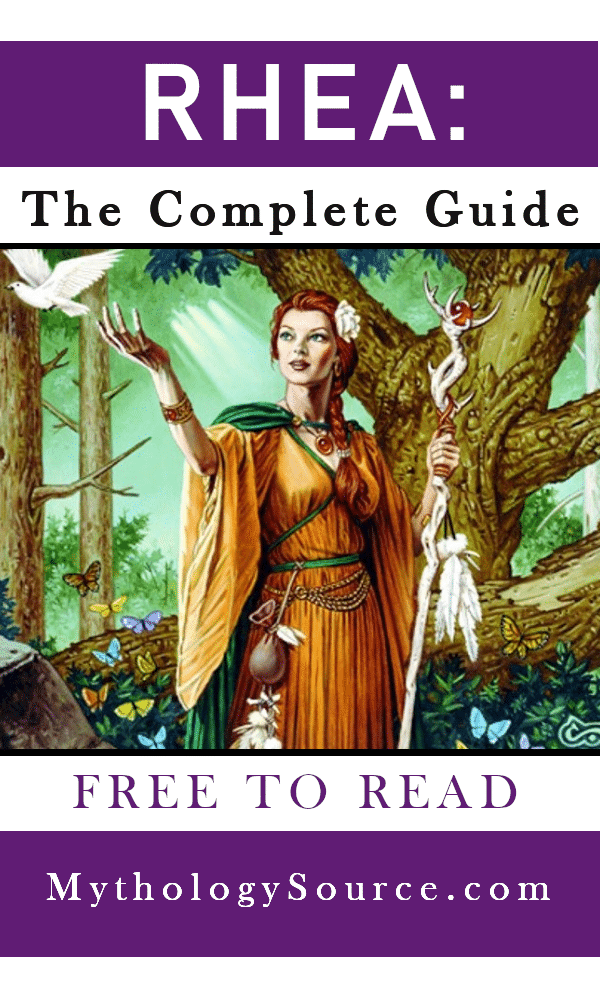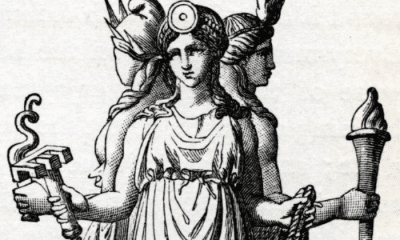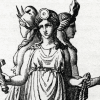
Greek
Rhea: The Mother of the Gods
Rhea: The Mother of the Gods
Often remembered just as the wife of Chronos, the goddess Rhea was much more than just Zeus’s mother!
Virtually every culture in the world reveres some sort of mother goddess. In the case of the Greeks, there were several.
Gaia is usually considered the Mother Earth and the source of all life. But, while she was an ancestor of most of the gods of Olympus, Gaia was not the one they called their mother.
That title went to Rhea, the mother of the six original gods of Olympus. By tricking her husband, she made sure that the world of the Olympians came into being.
Rhea was certainly an important figure in Greek mythology as the mother of Zeus and his siblings, but the full story of Rhea is a lot more complicated than just her children!
The Titaness Rhea
Rhea was one of the Titans, the twelve noble children of Gaia and Uranus.
As the children of the heavens and the earth, the Titans were the first generation of gods. There were six males and six females, each with incredible power.
Early in their lives, however, this power was limited. Their father, Uranus, tightly controlled his children.
Eventually, he was overthrown by one of them. His youngest son, Chronos, conspired with Gaia to castrate Uranus, thereby weakening him and allowing the Titan to take power for himself.
The Titans established a new home at Mount Othrys with Chronos as their king. They married one another, or occasionally their nieces and nephews, and gave rise to a host of new gods and goddesses.
Chronos, the king, married his sister Rhea. When their own children were born, however, the marriage proved itself to be an unhappy one.
The Birth of Zeus
Chronos had received a prophecy that one of his sons would someday be a great enough god to challenge him, just as he had done with his own father.
The king of the Titans had quickly become as obsessed with maintaining his own power as Uranus had been before him.
His siblings fared well, but the younger gods were limited in their positions and opportunities. He had also broken his promise to his mother, Gaia, that he would free the six giants she had given birth to that Uranus had imprisoned.
As he became more tyrannical, Chronos could not bear the idea that one day he would lose power to one of his own sons. He decided that he could avoid that fate by making sure none of his children ever grew to adulthood.
Rhea’s first child was a girl, Hestia. Share on XEven though the prophecy had said it would be a son that overthrew the king, Chronos took no chances.
Moments after Hestia was born, he swallowed his baby daughter whole.
He did the same with his next two daughters, Demeter and Hera. As soon as the baby was born he swallowed it.
After three daughters, Rhea gave birth to sons. Hades and Poseidon were eaten at birth as well.
With every child that Chronos devoured, Rhea grew more distraught. She hated her husband for the loss of her children.
When Rhea found herself pregnant for the sixth time, she went to her own mother for help. She could not stand to lose another child to her power-hungry husband.
Gaia, whose own children continued to be imprisoned by Chronos, knew her daughter’s pain all too well. She was happy to help Rhea hide the birth of her sixth child.
Gaia took Rhea to earth and hid her when she went into labor. Most ancient writers claimed her hiding place was somewhere on the island of Crete. Share on XWhen her third son, Zeus, was born he was concealed by Gaia. She provided giants to guard over him and make noise that would disguise the sound of his crying.
Some sources said that a nymph was enlisted to nurse the newborn and care for him. Other popular legends said that he was nursed by a goat.
It was not enough to just hide her baby, however. Rhea knew that Chronos would look for the child as soon as he knew she had given birth.
Rhea found a stone, known in legend as the Omphalos Stone, that was roughly the same size and weight as her newborn. She swaddled it tightly in blankets and brought it before her husband.
The trick paid off. Chronos swallowed the Omphalos Stone without a closer look, believing it to be the newborn.
Zeus was the last child Rhea gave birth to, and the first she had managed to save from her husband.
Zeus remained hidden as he grew up. When he reached adulthood, he returned to Mount Othrys in disguise to finally challenge his father.
With the help of his cousin, the Titaness Metis, Zeus tricked his father into vomiting up the children he had swallowed. One by one they were reborn.
The younger gods, led by Zeus, challenged the rule of the Titans. Following a war that lasted for ten years, the Titanomachy, Chronos was defeated and Zeus became king.
Most of the Titans, particularly among the original twelve, had sided with Chronos and were imprisoned alongside him in Tartarus. Rhea, as the mother who had saved Zeus and allowed the prophecy to be fulfilled, remained free.
Rhea took up a place on Mount Olympus, the home that the new gods had established. While she was generally counted as a Titan instead of an Olympian, the protection she had given Zeus afforded her a place in the new pantheon.
She was revered as Meter Theon, the Mother of the Gods. Rhea was not important because of her own powers, but because she had given birth to the six gods and goddesses who founded the Olympian pantheon.
She was present at many of the important events of Olympus, even though she did not play a direct role. She witnessed the birth of Apollo, attended the great feasts of the gods, and welcomed Demeter back to Olympus after the abduction of Persephone.
Rhea Cybele the Mother Goddess
As the Greek world expanded, its people came into increasing contact with the beliefs of other lands.
This was not an entirely new phenomenon. The mythologies of the Mediterranean and Near East had always influenced one another as trade and migration brought different cultures into contact.
In Anatolia, what is now modern Turkey, the type and level of the cultural exchange went far beyond simple trade. Asia Minor became increasingly incorporated into the Greek world.
Many Greek city-states established colonies in Anatolia. Great cities like Miletus, Ephesus, and Pontus were located not in Greece, but in Asia.
The result was a local blending of Greece and Anatolian cultures. The Greek colonies, while closely tied to their roots in Europe, absorbed many local beliefs and customs.
Among these was the worship of local gods. The Greek colonists did not replace their own pantheon, however; they incorporated the new gods they encountered as aspects or variations of existing deities.
Very often these foreign gods were so thoroughly Hellenized that they became recognized members of the Olympian pantheon.
At other times, the local gods were considered variations on one that was more familiar to the Greeks. This was the case with Cybele.
Cybele was the Anatolian mother goddess. As the region became Hellenized, Cybele was more and more closely associated with Rhea.
Both goddesses fell under the title of Meter Theon. The two mother goddesses are often indistinguishable in written legends.
For example, an inscription on a shrine read:
[Mousai (Muses)], come here from heaven and sing with me of the Meter Theon (Mother of the Gods), how she went wandering through the mountains and glens trailing her flowing hair and distraught in her mind. When lord Zeus saw the Meter Theon (Mother of the Gods), he threw a thunderbolt and smashed the rocks; and Kypris [Aphrodite] urged her and took the tambourines: ‘Mother, go off to the gods: father Zeus summons you; and do not keep on wandering over the mountains; have fierce lions or grey wolves become your friends?’ She replied, ‘I shall not go off unless I get my portions, half of heaven and half of the earth and a third portion, half of the sea: only then shall I go off.’ Greetings, great Meter (Mother), queen of Olympos!
This inscription, as it is written, could refer to either Rhea or Cybele. While a local Anatolian name is used for Aphrodite, Zeus by this time was considered the head of both pantheons and the inscription invokes the Greek Muses.
To add to the confusion, Asia Minor had its own mountain called Olympus. The Queen of Olympus could refer to two different goddesses, in two different places.
Eventually, a story grew up that Cybele and Rhea really were one and the same. It was said that Rhea had left Crete and traveled across the sea to escape Chronos, eventually setting up a new home in Anatolia.
A few writers took the opposite approach. They claimed that Meter Theon had originally come from Asia and moved to Crete to give birth to her son at Mount Ida.
The two are so closely linked that they are often referred to as Rhea-Cybele. While each has a few individual myths, for example very different birth and origin stories, they are so often called by the title Meter Theon that without context it is impossible to distinguish which goddess is meant.
The Other Mother Goddesses
Cybele was not the only other goddess Rhea was linked to.
Many historians that study Greek mythology today believe that many gods and goddesses were once different aspects of the same being. When a deity had several functions, the name for that function was sometimes separated to create a new god or goddess.
Within this theory, many members of the Greek pantheon who have closely-related spheres of influence may have once been the same, such as the war goddess Enyo and the goddess of discord Eris.
Others who have very different functions may have also once been the same. Hecate, for example, is sometimes considered to be an offshoot of the darker functions of Artemis.
As a goddess associated with motherhood and fertility, Rhea was often closely connected to many other goddesses of the pantheon.
- Gaia – The primordial mother goddess and Rhea’s mother, the Titaness is sometimes considered to be an anthropomorphized version of Mother Earth.
- Demeter – Both Rhea and her daughter were revered as protective mother goddesses associated with nourishment and growth. In a few records, Rhea was even said to have been Persephone’s mother in place of Demeter.
- Aphrodite – The goddess of beauty was also, like Rhea, revered as a fertility goddess. In some versions of Anatolian myths, particularly those of the Trojan War, Aphrodite is identified as Meter.
- Dionysus – While it’s unclear which other goddess this could be a connection to, some stories of Dionysus have the Meter Theon dancing and playing music among his revelers.
- Hera – As queens of the gods and deities of married women, Rhea and Hera often served similar functions.
Rhea the Flow and the Ease
The name Rhea has been translated as both “flow” and “ease.” As the mother goddess, she was associated with both of these concepts.
The flow of Rhea was connected to her femininity and fertility. It described the flow of menstrual blood, the gush of water at birth, and the nourishing flow of milk.
Rhea was considered a goddess from which all life and all blessings flowed. Share on XThe gods of Olympus ruled over and cared for mankind, but without Rhea they never would have existed.
She was called a mother of humans not because she was directly responsible for their creation, but because as the ancestress of the gods both mankind and all the blessings men received from the Olympians had their start with Rhea.
She was also a goddess of ease.
Homeric works often use the phrase “the gods who live at their ease.” The word ease in Greek was rhea, so the phrase meant both that the gods enjoy a leisurely life and that their life was thanks to their mother, Rhea.
Stories of Rhea after the Titanomachy often seem to depict a goddess who enjoyed the comforts and pleasures of the world. The gods held feasts in their mother’s honor, her priests played music to experience joy, and Meter Theon was shown dancing and playing the drums alongside the god of wine.
The Greeks believed that Meter Theon wanted them to have a life of ease as well. Mankind would always have to work hard for food and shelter, but Rhea provided comfort and pleasure whenever it was possible.
Worship of the Mother
It is difficult to distinguish shrines or altars of Rhea because she was so closely identified with other goddesses. However, it appears that there were no major temples dedicated in her honor.
She had a strong cult in Crete, where it was believed she had hidden to give birth to Zeus. Aspects of her worship there, such as drumming, were also found in cults tot he Meter Theon in Asia Minor.
Under this name, there were more temples. The Meter Theon was worshipped in Attica, Arcadia, and Corinth.
However, because the name was used so often, it is impossible to say whether these temples were dedicated in honor of Rhea, Cybele, or another goddess altogether.
In Roman times, a Temple of the Mother was recorded at Olympia. Being at Zeus’s holy site it would seem logical that the Meter referenced was his own, but by the time of the Empire no iconography of the goddess remained intact.
There were smaller sites considered holy to Rhea, however. Shrines on two mountains in Arcadia both claimed to have been built on the site where she tricked Chronos into swallowing the Omphalos Stone.
Surviving hymns to both Rhea and the Meter Theon, however, show that there was some worship of her throughout Greece. The hymns describe her as a protective goddess who found joy in the good works and happy lives of her followers.
The Mother Rhea
Ultimately, Rhea is a sometimes confusing character in Greek mythology. She was immensely important as the mother of Zeus who saved him from being eaten by his father at birth, but she seemed to have little purpose in her own right.
The Greek pantheon was filled with maternal goddesses and fertility figures. As characters like Cybele and Aphrodite were introduced from abroad, the importance of Rhea as a mother seemed even more diminished.
But, whether on her own or in conjunction with other goddesses, Rhea’s role as the mother of Zeus ensured that she would always have a place in the Greek pantheon. As one aspect of Meter Theon, the mother of the gods, she remained a central part of Greek religion.




